Radiogenic Isotope Facility
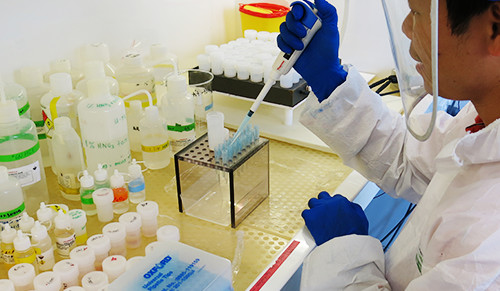
Our Radiogenic Isotope Facility is a significant and unique element of UQ’s research infrastructural base.
The $5 million laboratory is widely acknowledged by peers as being among the most advanced facilities of its kind in the world.
Features
The Radiogenic Isotope Facility houses seven ARC-, UQ-, and Griffith-funded strategic instruments, including one Nu Plasma HR Multi Collector-Inductively Coupled Plasma Mass Spectrometer (MC-ICP-MS), one Nu Plasma II MC-ICP-MS and one VG Sector-54 Thermal Ionization Mass Spectrometer (TIMS) for ultra-high-precision multi-isotope analysis and isotope dating, one Thermo X-Series II Quadrupole Inductively Coupled Mass Spectrometer (Q-ICP-MS), one Thermo iCAP-RQ Q-ICP-MS and one Agilent 7900 Q-ICP-MS mainly for high-precision rapid multi-element analysis, as well as an ASI RESOlution SE laser system for in situ high-spatial resolution isotope and elemental analysis when coupled with the above ICP-MS machines.
The facility’s equipment can also digest a variety of specimens and chemically separate and purify elements of interest for various isotope analysis using a range of ion exchange column procedures. The HEPA-filtered ultra-clean laboratory and centrally-controlled air-handling system makes our facility one of only a few that has such a high level of analytical sophistication and proven ultra-low analytical blank performance for earth, environmental, archaeological, biological, biomedical and forensic science research.
You can use the the facility to analyse a range of materials, including:
- igneous, metamorphic and sedimentary rocks
- soil, clays, sands, muds, dusts
- minerals, mineralised rocks or ores, concentrates, slags and alloys
- carbonates of various origins (such as corals, speleothem, limestones, calcretes travertine, tufa, and shells)
- ceramics and other stone artefacts
- fossil teeth and bones
- wood and other plant materials
- low-salinity waters
- seawater (needs special treatment)
- other biological, environmental or forensic samples
- synthetic materials.
For more details about specific facilities or pieces of equipment, scroll down to the Facilities table below.
Sample preparation requirements:
- Ideally silicate rock samples should be prepared in agate mills. This service is available from our Sample Preparation Laboratory.
- Samples used for trace element analyses must not be crushed in tungsten-carbide mills (due to contamination from W and other high-field-strength elements, which are extremely hard to wash in the ICP-MS).
- You must provide information about peculiar sample characteristics (for example, high Pb, Hg, W, Zn). We can provide this service at an extra cost.
- Sample pre-preparation that has to be performed beyond our lab capabilities, such as separation and hand-picking of minerals, will incur an extra cost. This service is available from our Sample Preparation Laboratory.
For more information, view our standards and procedures.
Availability
The Radiogenic Isotope Facility serves clients across seven UQ faculties and institutes.
To discuss your analytical requirements and sample preparation, email us:
- Scientific Manager, Professor Jianxin Zhao: j.zhao@uq.edu.au
- Technical Manager, Dr Yue-xing Feng: y.feng@uq.edu.au
Prices
See our prices for analyses.
Staff
Facilities
 HEPA-filtered ultra-clean laboratory complex
HEPA-filtered ultra-clean laboratory complex
- Total floor area: ~200m2.
- Comprises a HEPA-filtered Class 35 (100) temperature- and humidity-controlled clean room to house several mass spectrometers.
- Next to the mass spectrometer laboratory is a suite of sequentially pressurised, charcoal- (to remove lead from the air) and HEPA-filtered, metal-free chemistry laboratories, ranging in air quality from Class 3500 (10,000) to better than Class 35 (100).
- The air-handling system has performed extremely well during extremes of temperature and humidity, and has continued to maintain an environment with temperature of 22±0.5°C and 50±10% RH. Such tight control on the environment has had a major influence on the performance of the mass spectrometers which all exceeded very tight performance specifications.
Six positively pressured chemistry laboratories
Chemistry laboratories are available for:
- sample preparation and digestion
- balance room for sample weighting
- acid preparation, acid distillation and cleaning of low blank Teflon® ware
- U-series chemistry
- mainly Rb-Sr, rare earth element (REE) and other element chemistry
- mainly trace Pb chemistry.
The latter laboratory has the highest positive pressure and the largest number of air changes per hour (ca. 70). The chemistry suite is accessed via a gowning room that has a positive pressure relative to the entry corridor.
To avoid contamination due to corrosion in the acid environment, construction materials were selected to reduce the exposure of metal surfaces:
- wall surfaces and the ceilings are painted with numerous applications of acid-resistant epoxy
- bench tops are constructed of moulded white PVC
- under-bench cabinets have wheels to facilitate removal for routine cleaning.
HEPA and ULPA fume hoods
- The chemistry laboratory is equipped with HEPA- and ULPA- (99.999% filtration) filtered polypropylene hoods and work stations.
- Miniature wall-mounted HEPA- and ULPA-filtered evacuated enclosures equipped with Teflon®-encased hot plates provide an environment for sample evaporation during element extraction. These units have proven to be extremely effective in maintaining superb processing blanks.
Satorius analytical balance and Cahn microbalance
- Both are located in the balance room.
Acid distillation system
- Four Teflon® stills and two bottle Teflon® stills are housed in a HEPA-filtered hood for ultra-low blank reagent distillation.
- The Teflon® stills yield between one and three litres per day of trace-metal grade reagent.
Water
- The water system for the laboratory includes a de-ionised water plant producing <10 meg W water and a reverse osmosis system that feeds a Milli-Q® water system.
Instrumentation
Nu Instruments multi-collector inductively coupled plasma-mass spectrometer (MC-ICP-MS)
- Features a double-focusing analyser with zoom/variable dispersion ion optics, a modified detector configuration consisting of 12 Faraday collectors, and three discrete dynode ion counting multipliers (two of which have a deceleration lens filter behind each multiplier to enhance abundance sensitivity for accurate measurement of extremely low-abundance isotopes).
- A purpose-built automatic sample introduction system allows for high-precision and high-throughput isotope analyses of many elements in the periodic table, from lithium to uranium, for geological, geographical, marine, environmental, climatic, chemical, archaeological, forensic and biomedical applications. Analytical protocols for several elements, such as U, Th, Rb, Sr, Sm, Nd, Pb, Hf and Cd, are already set up. Protocols for other elements can be set up if research need is high.
- Particularly optimized for highly-efficient and precise U-Th dating of carbonates such as corals and speleothems.
Nu Instruments Nu Plasma II multi-collector inductively coupled plasma-mass spectrometer (MC-ICP-MS)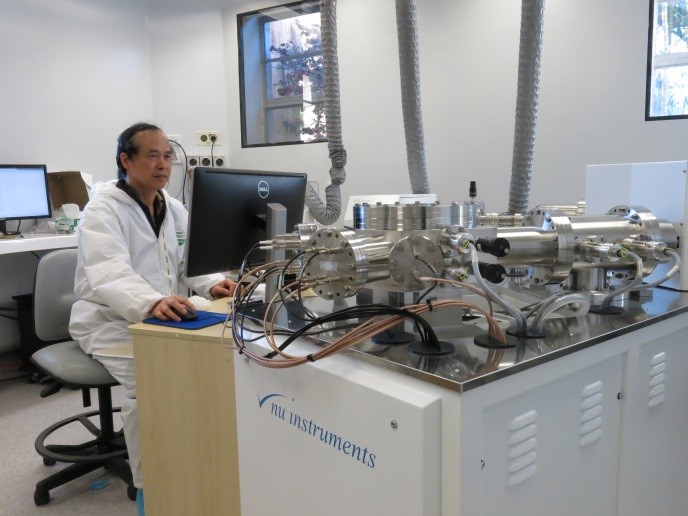
- Recently installed in 2017, the Nu Plasma II is a double focusing magnetic sector instrument that is fitted with 16 Faraday detectors and 6 ion-counting secondary electron multipliers to allow the vast majority of isotopes in the Periodic Table to be measured for earth, environmental, biological, biomedical, archaeological, forensic and material science research.
- The instrument is an evolution of the Nu Plasma HR, and represents the latest generation of MC-ICP-MS.
- When connected to the ASI RESOlution laser ablation system, this instrument is capable of highly-efficient in situ U-Pb dating of calcite, apatite and other high-U/Pb materials, in addition to zircon.
- Apart from U/Pb dating, this instrument is also suited to high-precision non-traditional metal stable isotope analysis, such as Fe, Mg, Zn, Cu, Mo, and Cr for environmental, biological and biomedical applications. Protocols for such elements can be set up if research need is high.
ASI RESOlution SE laser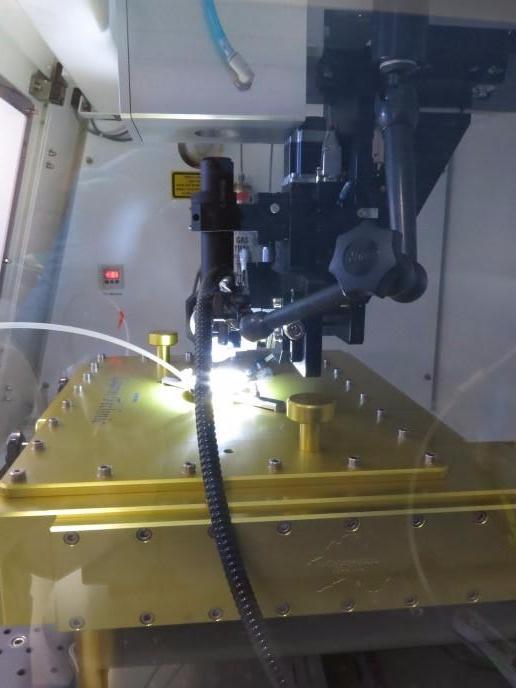
- The laser can be used for various applications that require in situ isotopic and elemental analysis.
- Our set-up features an ArF 193 (nm) gas excimer laser controlled with GeoStar software. Squid coil smooths out the signal on sample introduction line.
- Sample holders consist of a thin section and 1-inch round mount holder, universal holder and round sample holder.
- Five different ablation modes are available including single spots, transects and mapping.
- National Institute of Standards and Technology (NIST) standards are available for monitoring drift and for calculating concentrations in unknown samples as well as USGS and Max-Planck-Institut für Chemie (MPI-DING) reference glasses.
Thermo Fisher iCAP RQ quadrupole inductively coupled plasma mass spectrometer (ICP-MS)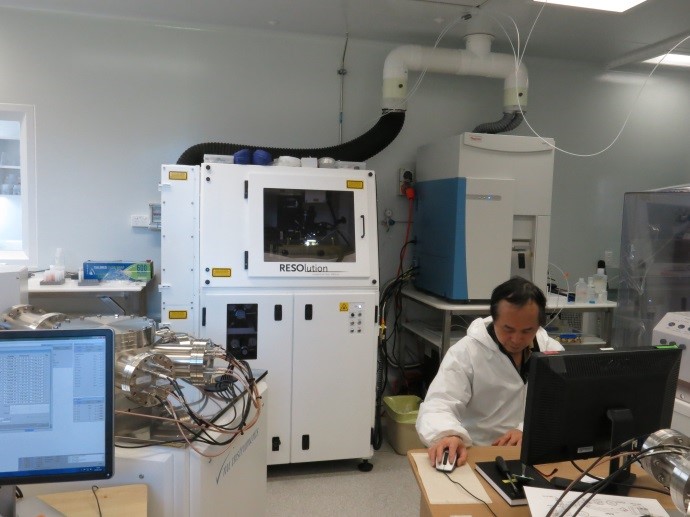
- Allows for trace and total element analysis of geological and environmental material via two sample introduction methods: laser ablation (via the ASI RESOlution system described above) and solution uptake.
- Powered by Qtegra software. Interference is removed with 1) Qcell; 2) Kinetic Energy Discrimination; 3) RAPID lens (right angle positive ion deflection), allowing for backgrounds of <0.5 cps.
- Three different sample cone inserts are available to accommodate samples of differing matrix: high matrix (3.5 mm), high robust (4.5 mm) and high sensitivity (2.8 mm for laser ablation). Sensitivity 900 k cps for 1 ppb 238U.
- Molybdenum quadrupole rods allow for low abundance sensitivity [0.5 ppm at M-1 (m=238U)], mass stability (±0.025 amu/8hrs), high scan speed (>90 000 amu/s) and high isotopic ratio precision (<0.1% RSD).
Agilent 7900 quadrupole Inductively-Coupled Plasma Mass-Spectrometer (ICP-MS) with collision cell
- This powerful, automated quadrupole ICP-MS uses innovative technology and a new MassHunter software platform.
- The matrix tolerance has been extended into the 10s of percentage total dissolved solids (TDS) range, allowing you to measure samples containing up to 25 per cent TDS.
- Boasts a linear dynamic range of up to 11 orders of magnitude (from sub-ppt to percentage-level concentrations), as well as a helium collision mode to minimise interference.
- Delivers superior-quality data with minimal drift and high precision (below 5 per cent RSD at low ppb levels).
- Also used for high-throughput Fe isotope analysis for environmental applications.
- Detection levels are in the ppt range for many elements.
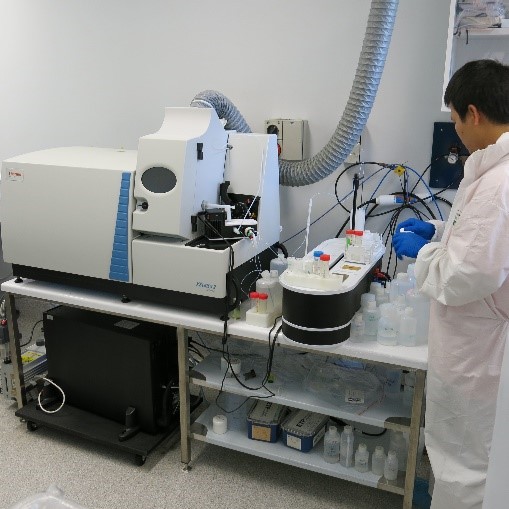 Thermo-X Series II quadrupole inductively coupled plasma-mass spectrometer
Thermo-X Series II quadrupole inductively coupled plasma-mass spectrometer
- Has high sensitivity and low background and is equipped with a PC3 automatic sample introduction system to achieve high throughput.
- Concentrated on high-throughput elemental ratio analyses for high temporal-resolution environmental and climatic research (such as reconstruction of past sea-surface temperature change on fortnightly to monthly resolution).
- Provides excellent analytical precisions (typically <5 per cent, with most <2 per cent) for more than 40 elements in the periodic table. Also offers high-throughput, high-precision elemental ratio analyses (for example, Sr/Ca, Mg/Ca, U/Ca, Ba/Ca, Mn/Ca) of corals and speleothems with external reproducibility typically <0.3 per cent for coral and Sr/Ca and <0.5 per cent for coral Mg/Ca.
Autoscan Lab for low-temperature thermochronology
- Located in the Richards Building (Building 210G), our Autoscan Lab is equipped with a Trackscan Plus Automated Counting System, manufactured by Autoscan Systems Pty Ltd.
- The Autoscan Lab represents our facility’s capacity in low-temperature thermochronology, particularly in fission-track dating. Apatite fission-track thermochronology measures the low-temperature history of ~60-120°C of a rock sample.
- The Autoscan Lab uses a series of in-house protocols for sample preparation and accesses the facility’s laser ablation systems for trace element measurements.
